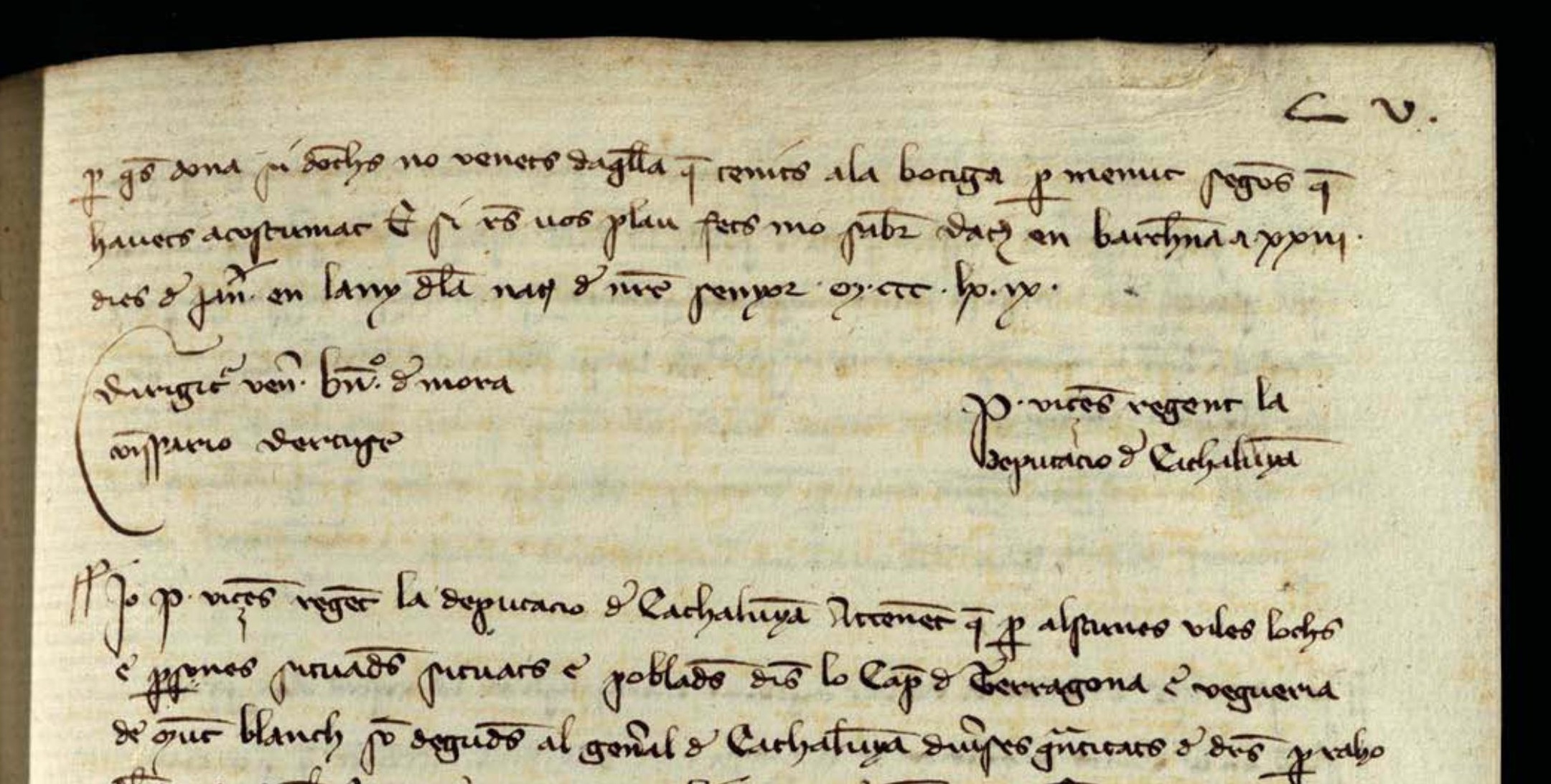Quim Torra is the 133rd president of the Generalitat, not the 131st, according to research by UPF
Quim Torra is the 133rd president of the Generalitat, not the 131st, according to research by UPF
Pere Ripoll, professor and doctor of Law by the University, has discovered two new presidents of the Catalan institution during the medieval period, Pere Vicenç and Bernat Bussot, according to research published in Revista de Estudios Histórico-Jurídicos. Until now, historiography had considered these two characters, who had replaced the system of collegiate governance of the Diputació del General with the system of regency, as mere managers or technocrats of the institution. The UPF researcher makes this discovery in the Llibre de Vuit Senyals (LVS), a manuscript he found in the General Archive of the Crown of Aragon while doing his doctoral thesis, which proves that the Generalitat was founded in 1359.

When writing his Industrial Doctorate straddled between UPF and Editorial Barcino publishing house, Pere Ripoll i Sastre made an important discovery in the General Archive of the Crown of Aragon, the Llibre de Vuit Senyals (LVS), to which no reference had been made for four hundred years: the manuscript proved which view was held in the Middle Ages regarding the founding regulations of the Generalitat, and placed its origins in the year 1359, earlier than had been previously thought.
The adjunct lecturer at the Department of Law and member of the UPF Research Group on the History of Catalan Law has continued doing research on this document, which has allowed him to discover the existence of two new presidents of the Generalitat: Pere Vicenç and Bernat Bussot, who would have held the office of regent between 1367 and 1375.
“I have seen that one closest thing to the current presidency experienced by the modern and medieval Generalitat was the institution’s regency system”.
The research that led him to discover two new presidents of the Generalitat during medieval times, recently published by Pere Ripoll in article in Revista de Estudios Histórico-Jurídicos, a renowned international publication dealing with the history of law, makes Quim Torra president number 133 of the institution, instead of 131, as had been previously thought.
“The research carried out in the LVS has provided us with unpublished information on the appointment of and powers conferred in these two presidents, who were at that time called regents and replaced the collegiate institutional governance system (a system that, keeping distances, would be similar to the current system of government of Switzerland) with a single-person system”, explains Pere Ripoll.
“Until now we did not have this information and the data were quite obscure, which is why historiography had considered that these two regents would have been a sort of technocrat at the head of the institution, which is why they were not considered presidents. With the LVS and other manuscripts I have examined at the Archive of the Crown of Aragon, I have seen that the closest thing to the current presidency experienced by the medieval and modern Generalitat was the institution’s regency system”, he adds.
Hence, Pere Ripoll considers that Pere Vicenç and Bernat Bussot should be taken into account in the numbering currently held: “Between 1367 and 1375 there is no record of a leader of the Generalitat, as if the institution had disappeared. And, especially, as if the two regents, who would occupy 5th and 6th places respectively (thus pushing the current numbering down by two), had not existed and had not led, or presided, to my understanding, the institution, as they did, however, based on powers and an established legal system”, he assures.

Evolution of a system of collegiate government towards the single-person regency system
The second half of the 14th century saw the period of the formation of the Generalitat de Catalunya. Its organizational structure underwent various changes, such as the replacement of its collegiate governing body of estate deputies by a regent. This change is due to the fact that the system of public debt favoured by the Diputació del General began to alarm the branches of the Corts Generals de Catalunya, who perceived malpractice (insufficient tax collection, and the existence of tax fraud) within the institution: this led the general community to take strong measures, such as the establishment of the regency system, after the Diputació was dismissed and audited.
The regency system, which initially fell with the figure of Pere Vicenç, acquired the powers of a plenipotentiary institution, as it replaced the deputies in all functions and powers. The regent had considerable powers, including law enforcement against those who refused to pay, in order put an end to the debt.
“The publication of the manuscript of the LVS provides a complete overview of the decisions taken between 1367 and 1369, which led to the replacement of the collegiate institution by an administration led by Pere Vicenç, along with a new team of auditors”, Pere Ripoll asserts. The institution of the regency became consolidated, and the legal status of some of its officers evolved.
The figure of regent, the most similar to the presidency of the institution
Until now, the historiography on the leaders of the Generalitat had considered that the closest thing to the presidency of the institution was the role played by the ecclesiastic deputy, “not because the legal regime of the medieval and modern Generalitat provided for this, but because it fell with him through protocol. Hence, the numbering of the presidents of the Generalitat prior to the contemporary institution has led to controversy and is an issue that always requires clarifying”, Pere Ripoll reflects. The fourth ecclesiastic deputy, just before the regency of Pere Vicenç, was Bernat Vallès (1365-1367).
According to Pere Ripoll, “the figure of the regent of the Diputació del General unifies the representation of the three estates of the Corts Generals de Catalunya, and, therefore, of the general community, in a single, secular person with a permanent governing council (instead of the auditors) who could not be disregarded. This makes the regency the closest to a “constitutional” and “republican” presidency of an institution in the Old Regime, since it had a legal system, especially as of the Corts of 1368-1369, was to present him as an ordinary, higher official of the central administration of the Diputació del General”.
Restoration of the system of deputies
The regent of the Diputació was to last nearly a decade. Then, in late 1374 and early 1375, deputies again appeared and the institution, as of 1376, had an organic structure representative of the consolidation phase, i.e., a stable, stratified organization of representation, and with a collegiate government of deputies and account auditors.
“It may be that the estates of the Corts did not trust the concentration of power in a single person at a time when they saw that the aim of putting an end to debt was not achieved, but indeed worsened, a key issue to understanding the continuity of the Generalitat and its growing institutional importance in the Principality, which is why they would choose to restore the system of deputies”, Pere Ripoll concludes.
Reference article: Ripoll, Pere (September 2020). “La Generalitat de Cataluña bajo el gobierno del regente Pere Vicenç (1367-1369)”. Revista de Estudios Histórico-Jurídicos, XLII (Valparaíso, Chile, 2020) (pp. 347-375).
